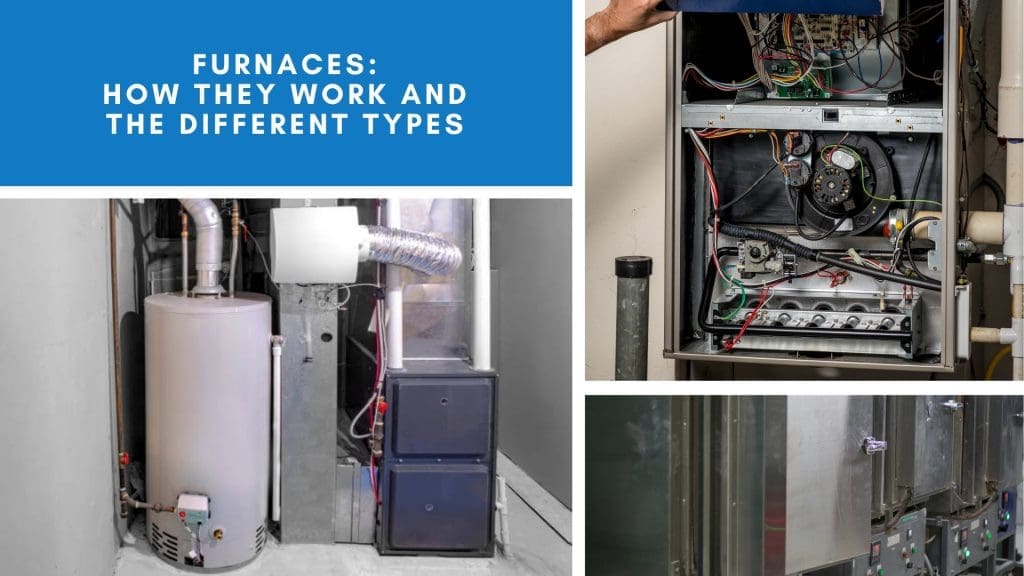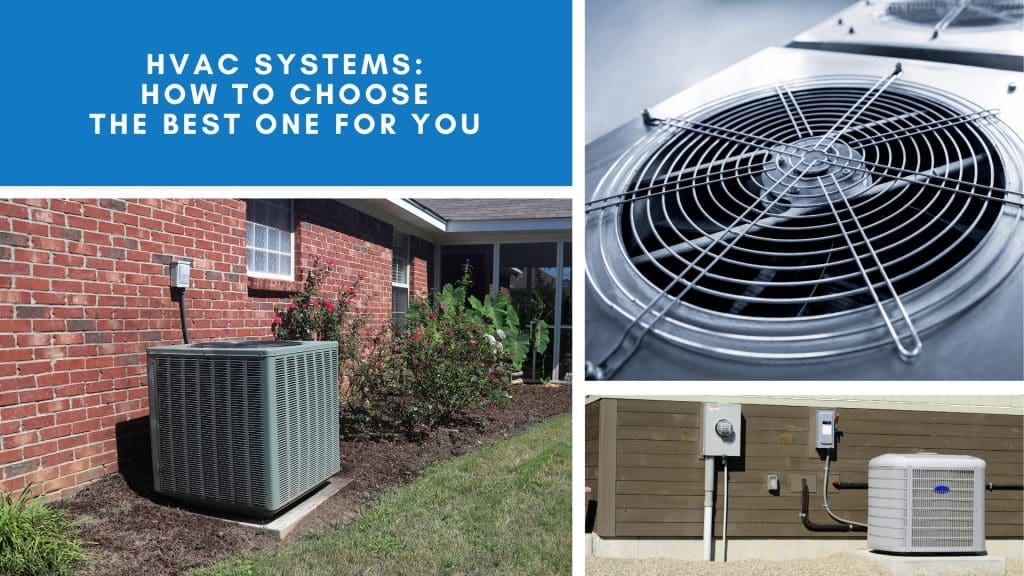How Heat Recovery Ventilators Optimize Home Ventilation & Your Energy Bill
In today’s world, maintaining a healthy home environment is crucial. Indoor air quality plays a significant role in our well-being. Many homeowners are turning to Heat Recovery Ventilators (HRVs) for a solution.
HRVs are designed to improve air quality by exchanging stale indoor air with fresh outdoor air. They do this while recovering heat from the outgoing air. This process not only enhances air quality but also reduces energy costs.
For homes that are tightly sealed, HRVs are particularly beneficial. They ensure a consistent flow of fresh air, which is essential for comfort and health. By maintaining a steady indoor temperature, HRVs enhance overall comfort.
Moreover, HRVs help reduce humidity levels. This prevents mold growth and improves air quality. They are different from Energy Recovery Ventilators (ERVs), which also manage humidity by transferring moisture.
Understanding how HRVs work can empower homeowners. It allows them to make informed decisions about their ventilation needs. In this article, we’ll explore how HRVs optimize home ventilation systems and energy bills.
What Is a Heat Recovery Ventilator (HRV)?
A Heat Recovery Ventilator (HRV) is an essential component for modern home ventilation. This device continuously replaces stale indoor air with fresh outdoor air. The brilliance of an HRV lies in its ability to reclaim heat from outgoing air.
Think of an HRV as a smart airflow manager. It uses a heat exchanger to transfer warmth from indoor air to incoming air. This results in less energy needed to heat or cool the home.
Here are some key aspects of an HRV:
- Heat Recovery: Transfers warmth from outgoing air to incoming air.
- Airflow: Ensures continuous exchange of indoor and outdoor air.
- Energy Efficiency: Reduces the need for additional heating or cooling.
An HRV is advantageous for tightly sealed homes. It compensates for the lack of natural ventilation and ensures a consistent indoor climate. This consistent exchange of air contributes to improved indoor air quality.
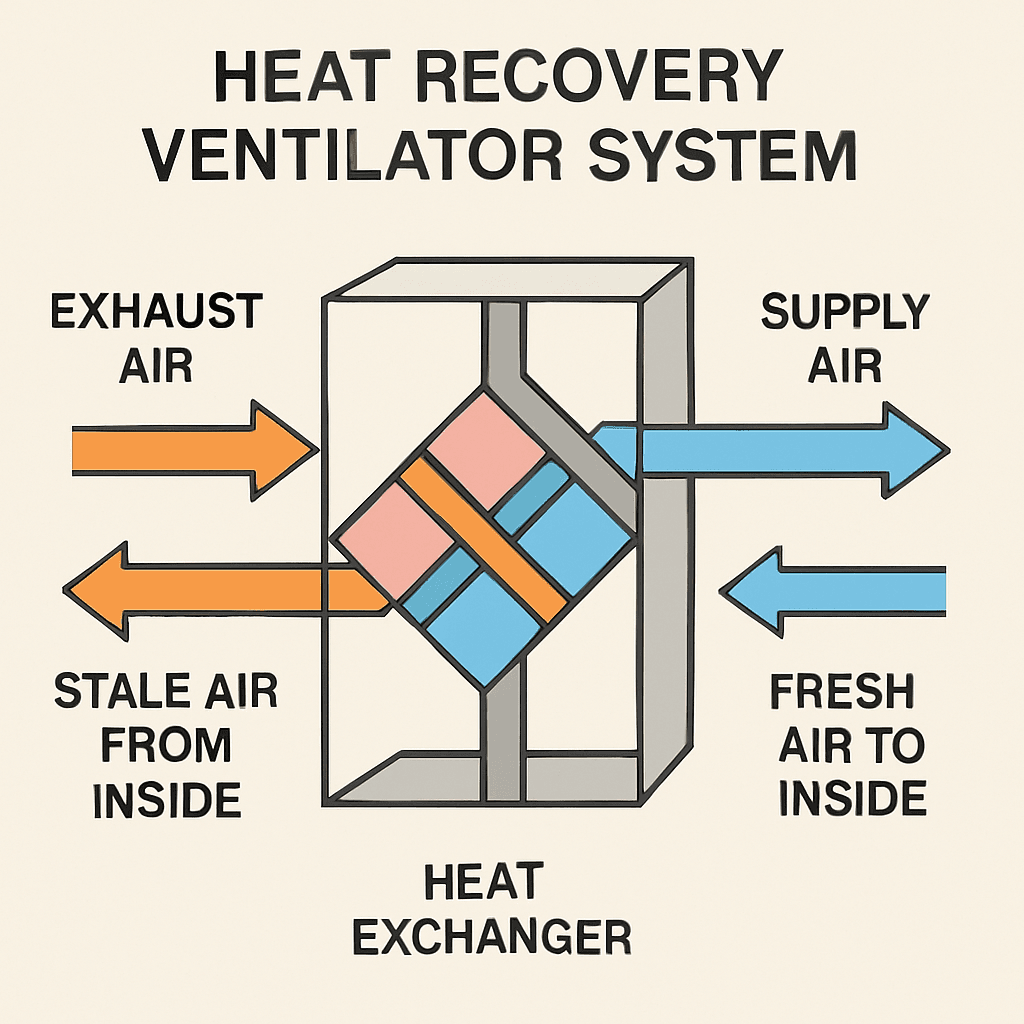
Overall, an HRV is more than just a fan—it is an investment in your home’s air quality. By reducing the energy needed to maintain comfort, it also saves on utility bills, making it a valuable addition to any home.
How Does Heat Recovery Work?
Understanding how heat recovery works can empower homeowners. An HRV system is designed to maximize efficiency by transferring heat between outgoing and incoming air. This process helps maintain a comfortable indoor climate without over-relying on your HVAC system.
An HRV operates by using a heat exchanger, a core component that allows heat transfer. As stale, warm indoor air is expelled, it passes close to incoming fresh air within the exchanger. Heat is transferred without mixing the two air streams.
Here’s how the basic process works:
- Warm Air Out: Exhausts warm, stale indoor air.
- Heat Transfer: Warms the incoming cooler fresh air.
- Fresh Air In: Supplies the home with tempered outdoor air.
The result is reduced energy usage for heating in the winter. Consequently, your HVAC system works less, leading to savings on your utility bills. HRVs are especially beneficial in colder climates where heat retention is crucial.
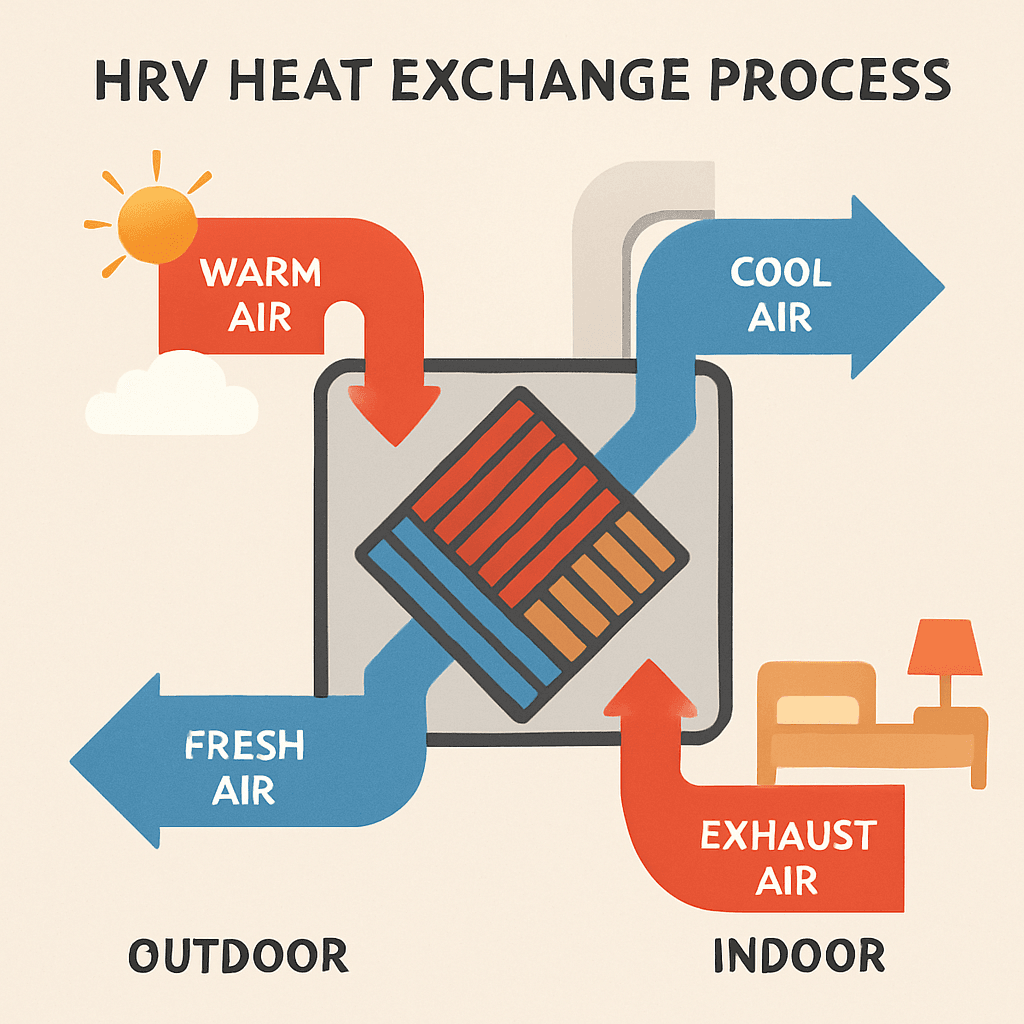
By understanding this process, homeowners can appreciate the efficiency of HRVs. The system’s simplicity is what makes it an effective and sustainable option for modern homes. Overall, HRVs optimize energy usage, enhance air quality, and contribute to a comfortable home environment.
HRV vs. ERV: What’s the Difference?
Choosing between an HRV and an ERV can be challenging. Both systems improve air quality, but they manage heat and moisture differently. Understanding these differences is crucial for selecting the right system for your home.
Heat Recovery Ventilators (HRVs) primarily focus on heat exchange. They transfer heat from outgoing air to incoming air, maintaining indoor temperatures. This process is ideal for homes in colder climates where retaining heat is essential.
Energy Recovery Ventilators (ERVs), on the other hand, handle both heat and moisture. They not only transfer heat but also manage humidity levels. This makes ERVs better suited for humid environments where moisture control is a priority.
Here’s a quick comparison:
- HRV: Best for colder climates, focuses on heat exchange.
- ERV: Better for humid climates, manages both heat and moisture.
By considering your home’s climate and humidity needs, you can choose the best system. Both HRVs and ERVs contribute to a healthier living environment by improving air quality and energy efficiency.
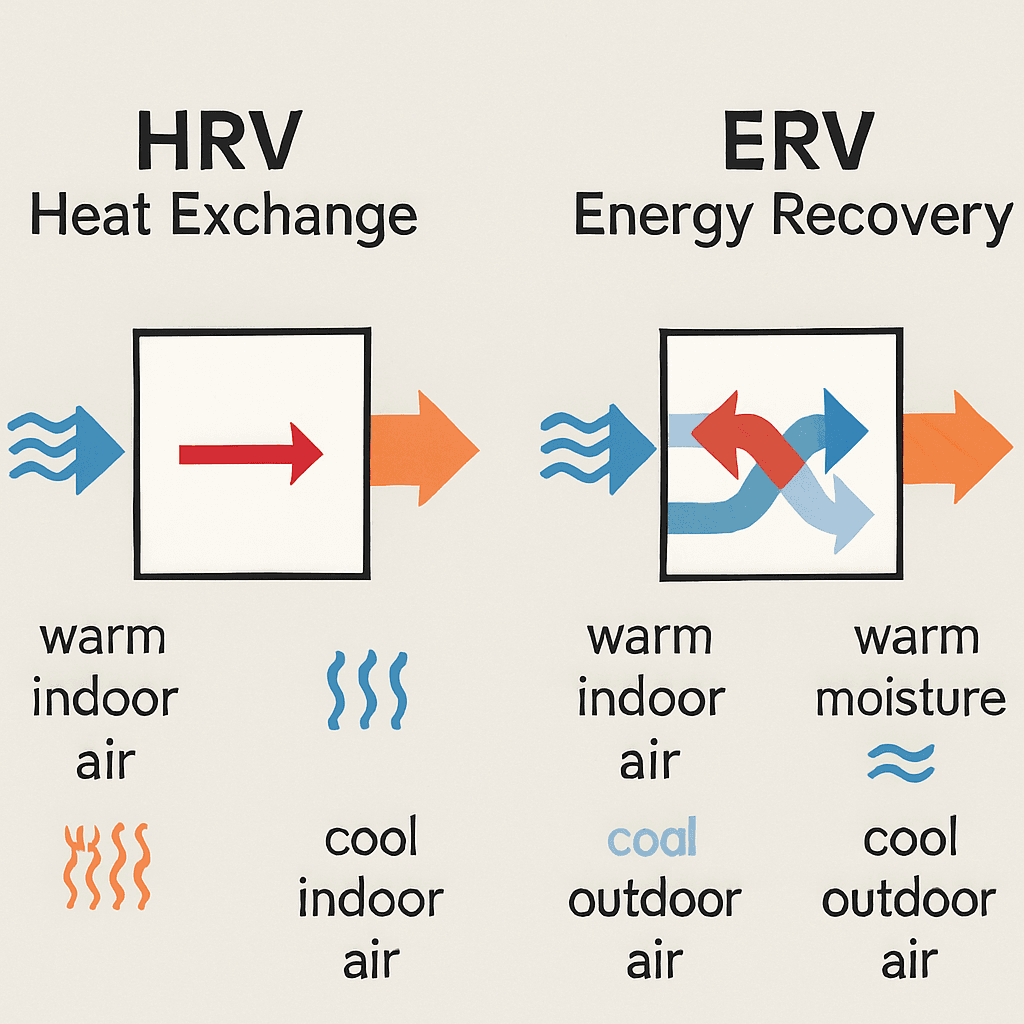
How HRVs Improve Indoor Air Quality
Heat Recovery Ventilators (HRVs) are transformative for air quality in homes. They continually exchange stale indoor air with fresh air from outside. This process ensures that you always breathe cleaner, fresher air indoors.
HRVs effectively filter out outdoor pollutants while bringing in fresh air. This reduces indoor air contaminants like dust, allergens, and odors. The result is a healthier environment for everyone in the home.
Another way HRVs boost air quality is by managing humidity levels. Lower humidity helps prevent mold growth and reduces dust mites. These improvements in air quality significantly benefit those with allergies and asthma.
Furthermore, HRVs support consistent air circulation throughout the house. Consistent airflow means every room receives fresh air, minimizing pollution buildup. This balance enhances overall indoor comfort and health.
In summary, HRVs improve air quality by:
- Exchanging stale air with fresh air.
- Filtering out dust and allergens.
- Reducing humidity and mold risk.
- Ensuring consistent air circulation.
By installing an HRV, homeowners enjoy a more comfortable and healthier indoor environment. Its benefits go beyond just ventilation, providing a comprehensive solution for better air quality.
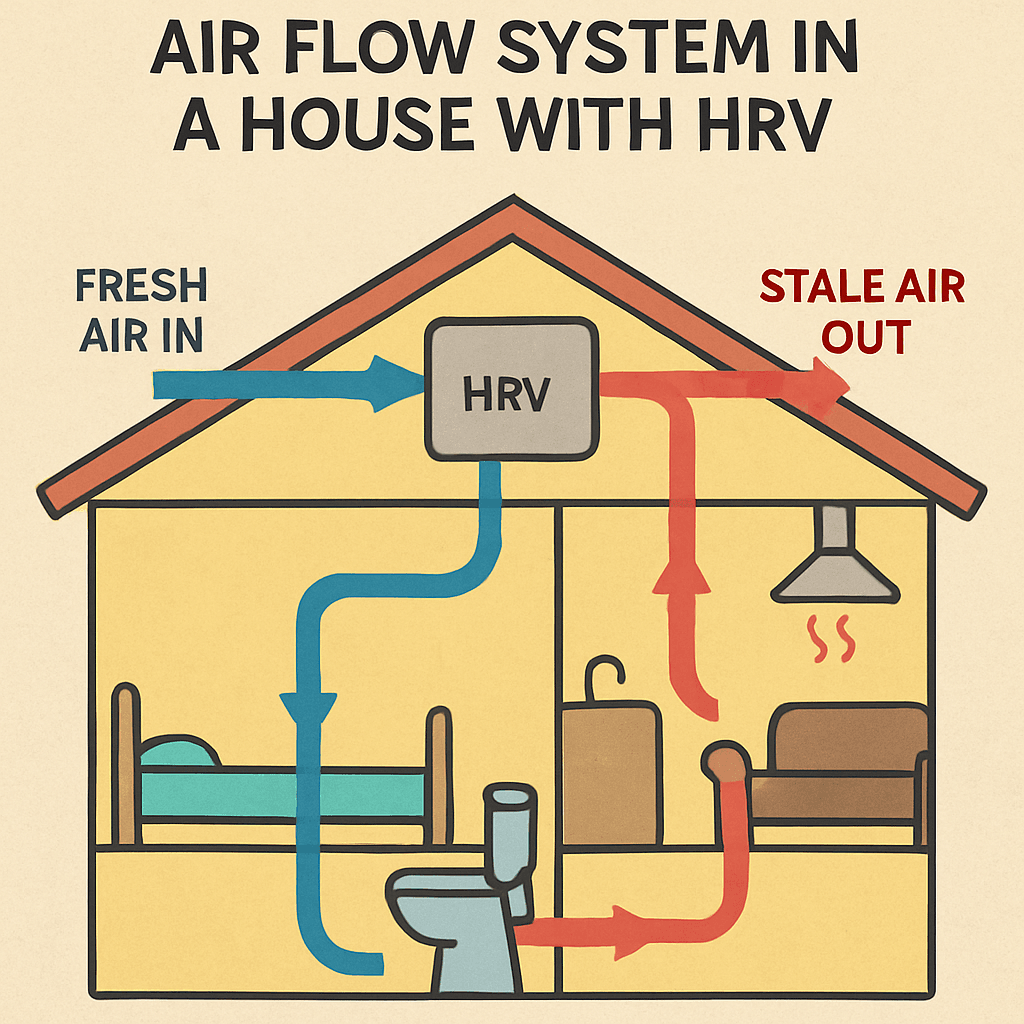
Energy Savings: How HRVs Lower Your Utility Bills
Heat Recovery Ventilators (HRVs) significantly reduce energy consumption in homes. They achieve this by recovering heat from the outgoing stale air. This recovered heat is then used to preheat the incoming fresh air, minimizing energy loss.
This heat recovery process is particularly beneficial during colder months. It reduces the need for additional heating since the incoming air is already warmer. This efficiency translates into noticeable savings on your utility bills.
Moreover, HRVs contribute to a more stable indoor temperature. By preventing heat loss, they ease the workload on your heating system. This reduced strain not only saves energy but also extends the lifespan of your HVAC system.
In addition, HRVs provide more efficient air exchange compared to traditional ventilation systems. This efficiency further cuts down on energy usage, adding to the overall cost savings.
- Reduces the need for additional heating
- Prevents unnecessary energy loss
- Eases workload on the HVAC system
- Efficiently exchanges air
The economic benefits of an HRV make it a wise investment for homeowners aiming to lower their utility expenses.
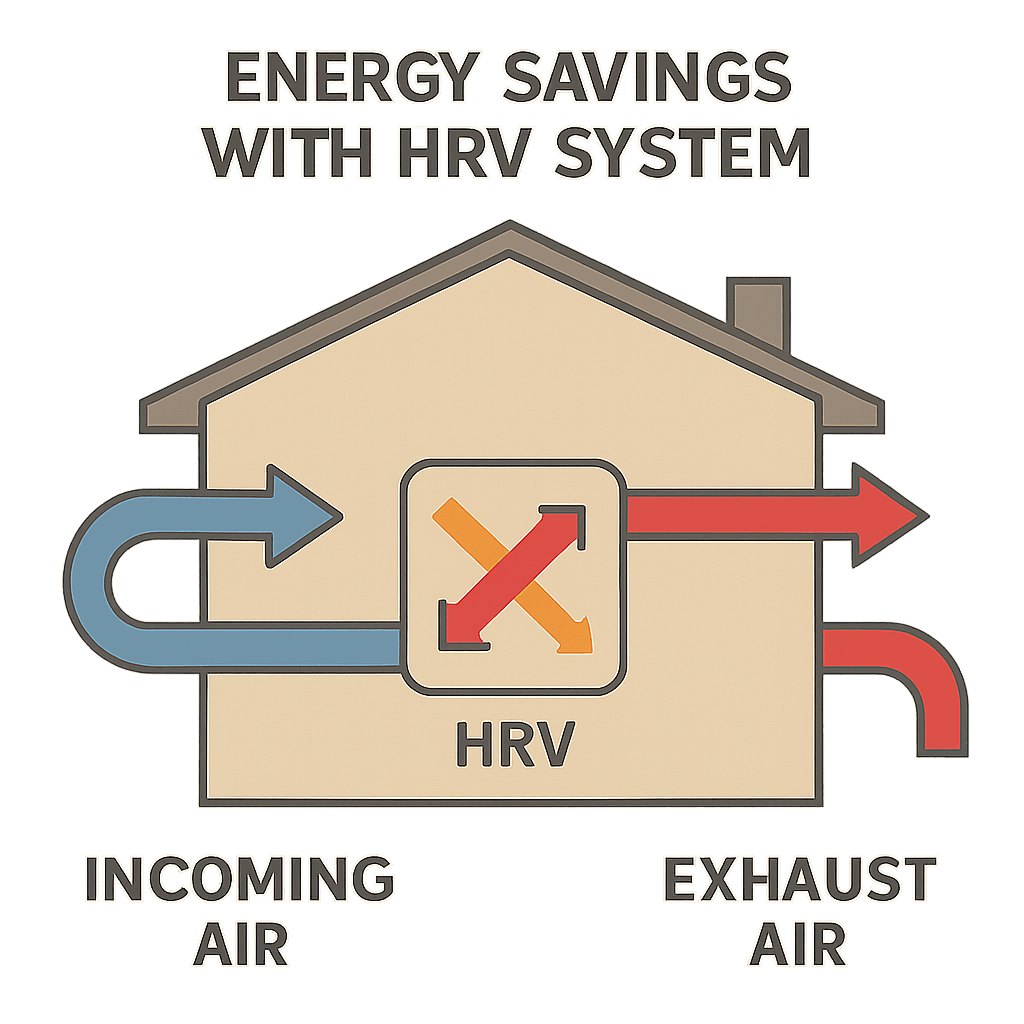
HRVs and Home Comfort: Temperature and Humidity Control
Heat Recovery Ventilators enhance home comfort by effectively regulating temperature and humidity levels. They ensure that the air in your home is not only fresh but also evenly distributed. This balance is crucial for maintaining a comfortable indoor environment year-round.
One of the key benefits of HRVs is their ability to manage indoor humidity. They help reduce excess moisture, which is vital for preventing mold growth and maintaining air quality. By controlling humidity, HRVs create a healthier, more comfortable living space.
Moreover, HRVs contribute to consistent temperature control. By exchanging air without significant heat loss, they keep rooms warm during winter and cool during summer. This consistency helps avoid temperature fluctuations that can make your home uncomfortable.
Benefits include:
- Regulating indoor humidity levels
- Consistent temperature control
- Prevention of mold and moisture issues
Ultimately, an HRV helps maintain an ideal home environment, enhancing both comfort and health.
Where HRVs Work Best: Climate and Home Considerations
Heat Recovery Ventilators are particularly effective in specific climates and types of homes. They are most beneficial in colder climates where preserving heat is a priority. By recovering and recycling the warmth from outgoing air, HRVs provide a natural solution to energy conservation challenges.
Homes that are tightly sealed also benefit greatly from HRVs. These homes, often found in newer builds or energy-efficient remodels, lack natural ventilation. An HRV ensures that fresh air circulates without losing heat, maintaining indoor air quality without sacrificing comfort.
Key considerations when using HRVs include:
- Cold climates
- Tightly sealed homes
- Homes seeking energy efficiency
When deciding if an HRV is right for your home, consider both climate conditions and building characteristics. This assessment will help you choose the most effective ventilation solution for your needs.
Integrating an HRV Into Your Home HVAC System
Incorporating a Heat Recovery Ventilator into your HVAC system can vastly improve efficiency. By seamlessly blending an HRV with your existing setup, you create a comprehensive solution that optimizes air exchange and energy usage. This integration ensures your home maintains a comfortable atmosphere while minimizing costs.
Adding an HRV is relatively straightforward and enhances an HVAC system’s performance. The HRV works in harmony with your existing system, recovering heat from outgoing air and using it to warm incoming fresh air. This balance reduces the workload on your heating and cooling units.
When integrating an HRV, keep these steps in mind:
- Assess compatibility with your current system
- Consider professional installation for optimal performance
- Schedule regular maintenance checks
By choosing to integrate an HRV, you’re investing in a future of comfort and efficiency. The right setup will keep your home both healthy and energy-savvy.
Maintenance and Longevity: Keeping Your HRV Running Smoothly
Proper maintenance of your Heat Recovery Ventilator is crucial for its efficiency and lifespan. Regular upkeep ensures that the system continues to perform effectively, providing fresh air and energy savings. An overlooked HRV can become less efficient, costing more in energy bills over time.
Routine tasks for maintaining your HRV include cleaning and replacing filters. This simple task prevents dust buildup, which can strain the system. Checking airflows to ensure unobstructed ventilation paths is another important step. Also, inspect the core where the heat exchange occurs for any blockages or residue.
Here are some maintenance tips:
- Clean or replace filters every 3-6 months
- Inspect vents and ducts for blockages
- Regularly check for unusual noises or decreased efficiency
By keeping a consistent maintenance schedule, your HRV will operate smoothly and extend its longevity. This practice not only secures ongoing energy savings but also maintains a healthy indoor environment.
Choosing the Right HRV System for Your Home
Selecting the right Heat Recovery Ventilator system for your home is a decision that impacts air quality and energy efficiency. Understanding your home’s needs is the first step. Factors like home size, climate, and existing HVAC systems should guide your choice.
Consider how the HRV system will integrate with your current setup. It’s crucial to ensure compatibility with existing ducts and controls. Some systems offer additional features that might be beneficial, like humidity control or advanced filtration.
Here’s a checklist to help guide your decision:
- Assess your home’s size and ventilation needs
- Consider climate: colder regions benefit more from HRVs
- Ensure compatibility with existing HVAC systems
- Look for additional features that meet your needs
Taking time to evaluate these factors helps ensure that the HRV you choose will effectively enhance your home’s ventilation and comfort.
Frequently Asked Questions About HRVs
When considering a Heat Recovery Ventilator, homeowners often have several questions. Understanding the basics can aid in making informed decisions. Here are a few common inquiries we hear.
How often should HRV filters be replaced? Ideally, HRV filters should be checked every three months and replaced as needed. Regular maintenance ensures peak performance.
Do HRVs operate year-round? Yes, an HRV can function throughout all seasons. It aids in maintaining consistent indoor air quality regardless of the weather outside.
Here’s a quick FAQ list to address more questions:
- What’s the lifespan of an HRV?
- Typically 10-15 years, with proper upkeep.
- Can HRVs increase heating bills?
- No, they often decrease overall energy costs.
- Is an HRV noisy?
- Most modern systems are designed to be very quiet.
These answers aim to provide clarity and assist you with your HRV considerations.
Conclusion: Is an HRV Right for Your Home?
Deciding on a Heat Recovery Ventilator requires thoughtful consideration. An HRV offers many benefits, particularly for energy efficiency and air quality. Understanding your home’s specific needs will guide your choice.
HRVs shine in climates where temperature control is key. They efficiently manage indoor air, keeping it fresh while conserving heat. If energy costs concern you, an HRV might be your ideal solution.
Consider your home’s design and ventilation needs. Tightly sealed homes often gain the most from HRVs. They ensure adequate air exchange without compromising efficiency.
Ultimately, the decision depends on your goals and environment. An HRV is a smart investment for those aiming to enhance comfort and sustainability. It not only improves the air you breathe but also your living experience. If your home fits the criteria, an HRV could be an excellent addition to your ventilation system.

